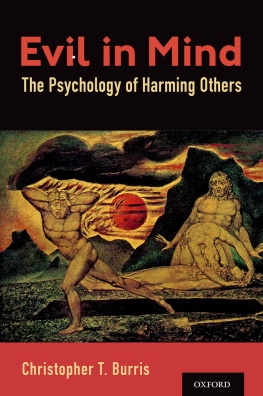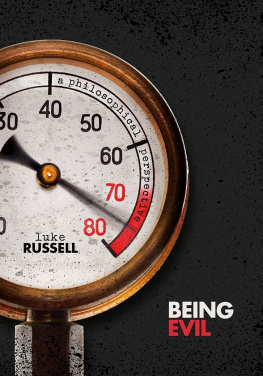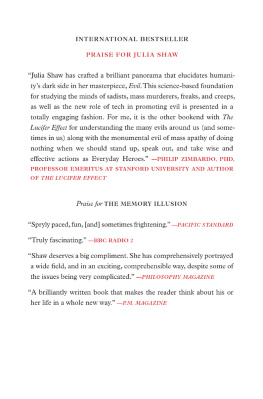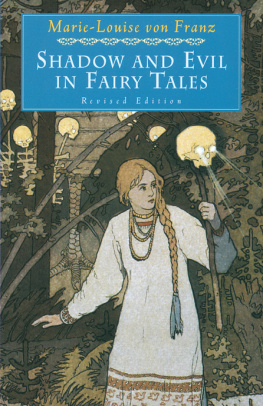Evil in Mind

Oxford University Press is a department of the University of Oxford. It furthers the Universitys objective of excellence in research, scholarship, and education by publishing worldwide. Oxford is a registered trade mark of Oxford University Press in the UK and certain other countries.
Published in the United States of America by Oxford University Press
198 Madison Avenue, New York, NY 10016, United States of America.
Oxford University Press 2022
All rights reserved. No part of this publication may be reproduced, stored in a retrieval system, or transmitted, in any form or by any means, without the prior permission in writing of Oxford University Press, or as expressly permitted by law, by license, or under terms agreed with the appropriate reproduction rights organization. Inquiries concerning reproduction outside the scope of the above should be sent to the Rights Department, Oxford University Press, at the address above.
You must not circulate this work in any other form and you must impose this same condition on any acquirer.
Library of Congress Cataloging-in-Publication Data
Names: Burris, Christopher T., author.
Title: Evil in mind : the psychology of harming others / Christopher T. Burris.
Description: New York, NY : Oxford University Press, [2022] |
Includes bibliographical references and index.
Identifiers: LCCN 2021052610 (print) | LCCN 2021052611 (ebook) |
ISBN 9780197637180 (hardback) | ISBN 9780197637203 (epub) |
ISBN 9780197637210
Subjects: LCSH: Aggressiveness. | CrueltyPsychological aspects. | Good and evil.
Classification: LCC BF 575 . A3 B79 2022 (print) | LCC BF 575 . A3 (ebook) |
DDC 155.2/32dc23/eng/20220105
LC record available at https://lccn.loc.gov/2021052610
LC ebook record available at https://lccn.loc.gov/2021052611
DOI: 10.1093/oso/9780197637180.001.0001
Contents
Its been over 20 years since I first created and taught a course called Psychology of Evil. As a quite new faculty member of the Department of Psychology at St. Jeromes University (part of the University of Waterloo, Canada), the course seemed like an odd-but-logical fusion of my research interests in the psychology of religion and my clinical interviewing experiences in a maximum-security prison. It was a happy coincidence that my course planning coincided with the release of Roy Baumeisters thought-provoking Evil: Inside Human Violence and Cruelty. That book has had a lasting impact on my thinkingand as the adopted course textbook, on literally thousands of my students.
With two more decades of human history behind us, the topic of evil seems no less relevant. But because theres been more thinking and (a lot!) more relevant research undertaken in that span, now seems like as good a time as any to revisit the topic from a psychological perspective. Before we launch into that, however, it makes sense to give you some idea of what to expectand what not to expectin this book.
The four chapters in aims to offer you some insight regarding the mindset behind such choices.
s core principles play out in each of these specific contexts.
The brief Epilogue (otherwise known as . I also try to anticipate and address at least some of the nagging questions that may pop into your head as you read. By the time youre done, I hope youll have begun to develop your own answers to the two biggest questions that reading any book of this sort should provoke: So what? and Now what?
Having laid out where you and I are headed in broad terms, there are a few more things that ought to be addressed. For example, one of my big challenges was to settle on the right writing style so that a broad swath of readerspsychology students, fellow academics, indulgent friends and relatives, and interested laypeoplewould find this book both accessible and informative. As I hope you can see already, Ive opted for a somewhat informal, conversational style when I can. Having said that, because this book takes a psychologicalversus, say, a philosophical or theologicalapproach to evil, Ive also tried to link the ideas I present to existing research when it seems relevant. That means that the writing will get a little technical sometimes. My hope is that unpacking how certain studies were conducted will help you better understand and appreciate whatever implications for the psychology of evil we might be trying to draw from them.
Because every research study has its limitations, it also has its critics. Some are quick to dismiss a studys findings based on some methodological detail or because the studys participants were too ________ (few, similar to each other, etc.). For others, the dismissal seems more personal: Well, thats not my experience. Its true that no single studyor set of studiescan give a once-for-all-time-and-all-people declaration of truth. But, by documenting trends and tendencies, research can tell us what certain people are more likely to do, and under what circumstances. And when trying to understand evil, Id argue that thats way better than nothing.
At the same time, Id certainly agree that its beneficial whenever researchers can gather information from different parts of the world when trying to understand a specific phenomenon. Thats why, throughout this book, Ive made a point to identify the countries in which the research I discuss was conducted, and/or from which the authors hail. Unless the context makes it clear, youll see those countries listed alphabetically in brackets wherever the work is first cited in a chapter. (Note that I use [international] when more than two countries are involved.) Although I limited my search to English-language sources and did not attempt to be exhaustive, especially when theres a ton of work on a particular topic, Im pleased that I could include evil-relevant research from six continents in this book. Sorry for the snub, Antarctica.
I also included a few stories. Of course, the biggest downside of specific examples is that any one is likely to contain so many peculiarities that its hard to generalize beyond it. In this respect, anecdotes are certainly of more limited value compared to the studies to which Ive just alluded. Nevertheless, I know that a well-chosen real-world example can grab your attention... and engage your emotions. This is particularly important in a book about the psychology of evil. To be blunt, I need to make you feel at least somewhat uncomfortable. Otherwise, whatever Im writing about will probably not seem evil enough. At the same time, Ive made a conscious choice to present only the details necessary for you to get the point of a specific example. Beyond that is sensationalism, voyeurism, and ghoulishnessnone of which, I would argue, helps you understand evil from a psychological perspective.
Before we launch in, I want to offer a big thanks to St. Jeromes University (in the University of Waterloo, Canada): Without the ridiculous privilege of a year-long sabbatical courtesy of SJU, this book never would have happened. Thanks also to John Rempel and Geoff Navaraboth colleagues and dear friendsfor the evil-related research collaborations and discussions over the years. Thanks to Ray Paloutzian for his unfailingly warm mentorship and encouragement. Thanks to Roy Baumeister for his 1997 book, and for feedback on early drafts of some of s chapters. Thanks to Nadina Persaud, Katie Pratt, and everyone else at Oxford University Press who made it possible for you to read this sentence right now. Thanks to my many undergraduate research assistantsmost recently Tansyn Hood and Marina Vrebacwho have helped with collecting data and digging into relevant literature, and to those Psychology of Evil students whose interest and enthusiasm inspires me to keep on trying to figure this stuff out. Lastly, thanks to those who have loved me enough to encourage me to walk through the world with more mindful, thoughtful stepsif this book does any good for you as a reader, please thank them in your own mind as well.














